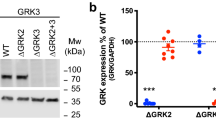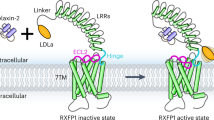Abstract
To control G protein signaling in vivo, we have modified G protein–coupled receptors to respond exclusively to synthetic small molecule agonists and not to their natural agonist(s). These engineered receptors are designated RASSLs (receptor activated solely by a synthetic ligand). A prototype RASSL (Ro1) based on the Gi–coupled κ opioid receptor was expressed in transgenic mice under the control of the tetracycline transactivator (tet) system. Activation of Ro1 expressed in the heart decreased heart rate by up to 80%, an expected effect of increased Gi signaling. Maximal heart rate changes occurred in less than 1 min, demonstrating the speed of this inducible signaling system. This Ro1–mediated slowing of heart rate was also subject to desensitization, which lasted more than 24 h. Both the initial effect on heart rate and the desensitization occurred, even though Ro1 is derived from a human opioid receptor not normally involved in heart rate control. In addition, the tet system was used to induce Ro1 expression in hepatocytes and salivary gland, where Gi signaling is known to control physiologic events such as proliferation and secretion. These studies demonstrate that a RASSL can be inducibly expressed in several mouse tissues and used in vivo to activate G protein signaling in a controllable fashion.
This is a preview of subscription content, access via your institution
Access options
Subscribe to this journal
Receive 12 print issues and online access
$209.00 per year
only $17.42 per issue
Buy this article
- Purchase on Springer Link
- Instant access to full article PDF
Prices may be subject to local taxes which are calculated during checkout






Similar content being viewed by others
References
Gossen, M. and Bujard, H. 1992. Tight control of gene expression in mammalian cells by tetracycline–responsive promoters. Proc. Natl. Acad. Sci. USA 89: 5547–5551.
Spencer, D.M., Wandless, T.J., Schreiber, S.L., and Crabtree, G.R. 1993. Controlling signal transduction with synthetic ligands. Science 262:1019– 1024.
Wang, Y., O'Malley, B.W., Jr., Tsai, S.Y., and O'Malley, B.W. 1994. A regulatory system for use in gene transfer. Proc. Natl. Acad. Sci. USA 91: 8180–8184.
No, D., Yao, T.–P., and Evans, R.M. 1996. Ecdysone–inducible gene expression in mammalian cells and transgenic mice. Proc. Natl. Acad. Sci. USA 93:3346–3351.
Coward, P., Wada, H.G., Falk, M.S., Chan, S.D.H., Meng, F., Akil, H., and Conklin, B.R. 1998. Controlling signaling with a specifically designed Gi–coupled receptor. Proc. Natl. Acad. Sci. USA 95:352– 357.
Lefkowitz, R.J., Hoffman, B.B., and Taylor, P. 1990. Neurohumoral transmission: the autonomic and somatic motor nervous systems, pp. 84– 121 in Goodman and Gilman's the Pharmacological Basis of Therapeutics . Gilman, A.G., Rall, T.W., Nies, A.S., and Taylor, P. (eds.). Pergamon Press, New York, NY.
Holmer, S.R. and Homcy, C.J. 1991. G proteins in the heart: a redundant and diverse transmembrane signaling network. Circulation 84:1891–1902.
Newton, G.E., Parker, A.B., Landzberg, J.S., Colucci, W.S., and Parker, J.D. 1996. Muscarinic receptor modulation of basal and b–adrenergic stimulated function of the failing human left ventricle. J. Clin. Invest. 98:2756–2763.
Fu, L.–X., Liang, Q.–M., Waagstein, F., Hoebeke, J., Sylvén, C., Jansson, E. et al. 1992. Increase in functional activity rather than in amount of Gi–a in failing human heart with dilated cardiomyopathy. Cardiovasc. Res. 26:950– 955.
Yu, Z., Redfern, C.S., and Fishman, G.I. 1996. Conditional transgene expression in the heart. Circ. Res. 79:691– 697.
Kistner, A., Gossen, M., Zimmerman, F., Jerecic, J., Ullmer, C., Lübbert, H. et al. 1996. Doxycycline–mediated quantitative and tissue–specific control of gene expression in transgenic mice. Proc. Natl. Acad. Sci. USA 93:10933 –10938.
Ewald, D., Li, M., Efrat, S., Auer, G., Wall, R.J., Furth, P.A. et al. 1996. Time–sensitive reversal of hyperplasia in transgenic mice expressing SV40 T antigen. Science 273:1384– 1386.
Appleyard, S.M., Patterson, T.A., Jin, W., and Chavkin, C. 1997 . Agonist–induced phosphorylation of the κ–opioid receptor. J. Neurochem. 69:2405– 2412.
Sterne–Marr, R. and Benovic, J.L. 1995 . Regulation of G protein–coupled receptors by receptor kinases and arrestins. Vitam. Horm. 51:193– 234.
Freedman, N.J. and Lefkowitz, R.J. 1996. Desensitization of G protein–coupled receptors. Recent Prog. Horm. Res. 51:319–353 .
Schwenk, F., κühn, R., Angrand, P.–O., Rajewsky, K., and Stewart, A.F. 1998 . Temporally and spatially regulated somatic mutagenesis in mice. Nucleic Acids Res. 26:1427– 1432.
Ho, S.N., Biggar, S.R., Spencer, D.M., Schreiber, S.L., and Crabtree, G.R. 1996. Dimeric ligands define a role for transcriptional activation domains in reinitiation. Nature 382:822–826.
Farrar, M.A., Alberola–Ila, J., and Perlmutter, R.M. 1996. Activation of the Raf–1 kinase cascade by coumermycin–induced dimerization. Nature 383:178–181.
Spencer, D.M. 1996. Creating conditional mutations in mammals. Trends Genet. 12:181–187.
Milano, C.A., Allen, L.F., Rockman, H.A., Dolber, P.C., McMinn, T.R., Chien, K.R. et al. 1994. Enhanced myocardial function in transgenic mice overexpressing the b2–adrenergic receptor. Science 264:582– 586.
Böhm, M., Eschenhagen, T., Gierschik, P., Larisch, K., Lensche, H., Mende, U. et al. 1994. Radioimmunochemical quantification of Gia in right and left ventricles from patients with ischaemic and dilated cardiomyopathy and predominant left ventricular failure. J. Mol. Cell. Cardiol. 26:133–149.
Schnabel, P. and Böhm, M. 1996. Heterotrimeric G proteins in heart disease. Cell. Signal. 8: 413–423.
Spiegel, A.M., Shenker, A., and Weinstein, L.S. 1992. Receptor–effector coupling by G proteins: implications for normal and abnormal signal transduction. Endocr. Rev. 13:536–565 .
Simonin, F., Valverde, O., Smadja, C., Slowe, S., Kitchen, I., Dierich, A. et al. 1998. Disruption of the κ–opioid receptor gene in mice enhances sensitivity to chemical visceral pain, impairs pharmacological actions of the selective κ–agonist U–50,488H and attenuates morphine withdrawal. EMBO J. 17:886–897.
Acknowledgements
We thank Robert W. Mahley and Murielle M. Veniant for valuable discussions and advice; Lara Jensen and Dale Newland for histochemistry assistance; and Gary Howard, Stephen Ordway, and Jane Peredo for editorial assistance. G. Fishman is an established investigator of the American Heart Association. This work was supported by the J. David Gladstone Institutes and the National Institutes of Health Grants CA71779 (C.H.R.) and HL60664–01 (B.R.C.).
Author information
Authors and Affiliations
Corresponding author
Rights and permissions
About this article
Cite this article
Redfern, C., Coward, P., Degtyarev, M. et al. Conditional expression and signaling of a specifically designed Gi-coupled receptor in transgenic mice. Nat Biotechnol 17, 165–169 (1999). https://doi.org/10.1038/6165
Received:
Accepted:
Issue Date:
DOI: https://doi.org/10.1038/6165
This article is cited by
-
Gini Correlation for Feature Screening
Acta Mathematicae Applicatae Sinica, English Series (2021)
-
A note on quantile feature screening via distance correlation
Statistical Papers (2019)
-
Molecular Characterization of Pediatric Restrictive Cardiomyopathy from Integrative Genomics
Scientific Reports (2017)
-
Sure screening by ranking the canonical correlations
TEST (2017)
-
Robust U-type test for high dimensional regression coefficients using refitted cross-validation variance estimation
Science China Mathematics (2016)



